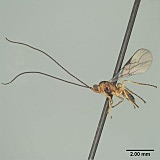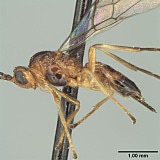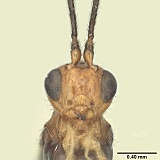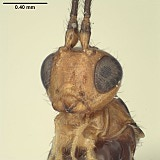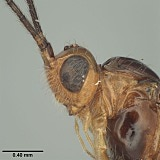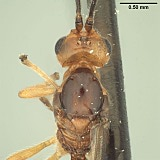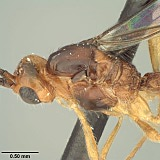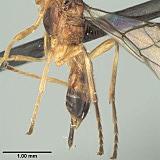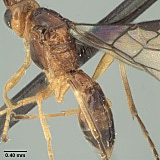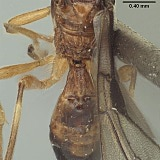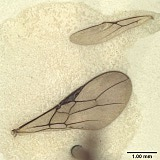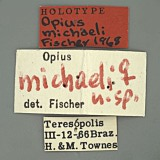Opius michaeli Fischer
Opius michaeli: Fischer 1971: 87 (catalog).
Opius (Merotrachys) michaeli: Fischer 1977: 655–657, 687–689 (key, redescription); Fischer 1979: 264–266 (key); Fischer 1983: 83 (diagnosis in couplet of key); Yu et al. 2005, 2012 (electronic catalogs).
The female is readily distinguished from all others included here in the ingenticornis species group by the slightly longer ovipositor and mottled color pattern (Fig. 2). Where known, members of the ingenticornis species group all have relatively short ovipositors, with the ovipositor sheath distinctly shorter than the mesosoma. The propodeum of O. michaeli is generally similar in sculpture to those species in the subgroup discussed under the O. gabrieli species page, but is nearly smooth anteriorly. Fischer (1983) compared O. michaeli to O. monsonicus from Peru and both have similarly long ovipositors. Although O. monsonicus has antennae that are very long as in members of the ingenticornis species group, we have excluded this species primarily on the basis of the propodeum, which is described as having a basal keel or midridge.
Additionally, as in all other members of the ingenticornis species group, this species can be further characterized as follows: Mandible short, broadly triangular, dorsal margin strongly angled ventrally, broadly exposing labrum. Clypeus shaped as a broad crescent, nearly hemispherical, flat to weakly protruding ventrally, ventral margin shallowly concave, rarely appearing truncate. Malar sulcus distinct, complete. Antenna unusually long, approximately twice longer than body; first flagellomere slender, longer than second, with long, narrow plate sensilla. Occipital carina broadly absent dorsally, the gap in dorsal view at least as wide as distance between eyes; carina well developed laterally and ventrally, widely separated from hypostomal carina ventrally. Pronope deep, wide, posterior margin at least weakly overlapping base of mesoscutum, thus obliterating posterior transverse sulcus medially; vertical carina absent on pronotum laterally. Mesoscutum without midpit; notaulus short, curved, pit-like anteriorly, narrowing and evanescent posteriorly. Propodeum with median depression at least anteriorly, never with median longitudinal carina. Mesopleuron without sternaulus, precoxal sulcus unsculptured, absent or very faintly indicated; hind margin of mesopleuron not obviously crenulate on dorsal 0.5. Fore wing 2CUb arising from or near middle of first subdiscal cell. Hind wing with RS distinctly infumate; m-cu absent. T1 with dorsal carinae parallel or nearly so, extending from base to apex; laterope large, deep; dorsope absent.
There are no specimens currently determined for this OTU, or those specimens determined for this OTU are not yet mappable.
This material is based upon work supported by the National Science Foundation under Grant Number DEB 0949027 and associated REU supplement 1213790.
Any opinions, findings, and conclusions or recommendations expressed in this material are those of the author(s) and do not necessarily reflect the views of the National Science Foundation.

